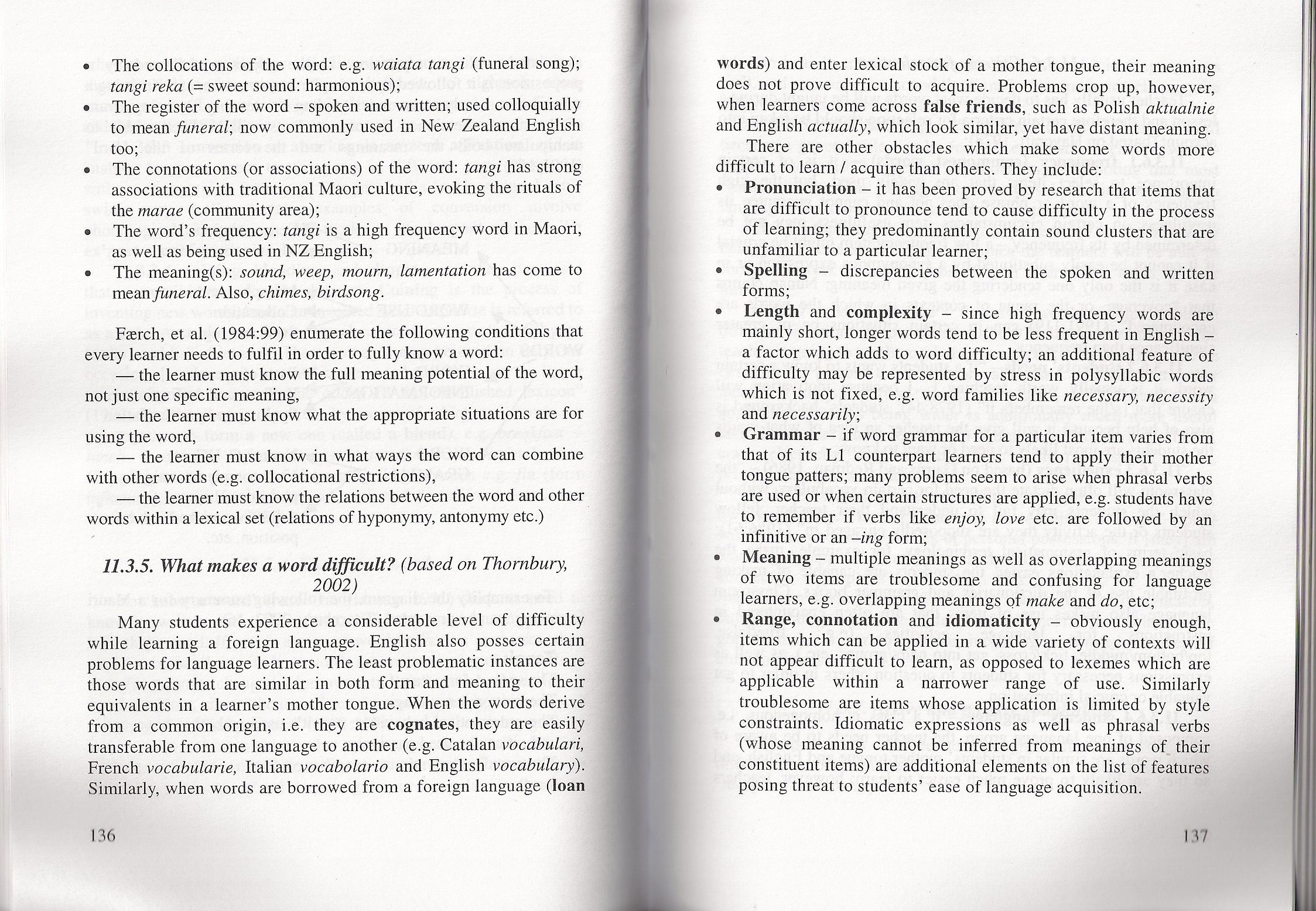10233 skanowanie0068 (3)

• The collocations of the word: e.g. waiata tangi (funeral song); tangi ręka (= sweet sound: harmonious);
• The register of the word - spoken and written; used colloąuially to mean funeral; now commonly used in New Zealand English too;
• The connotations (or associations) of the word: tangi has strong associations with traditional Maori culture, evoking the rituals of the marae (community area);
• The word’s ffeąuency: tangi is a high freąuency word in Maori, as well as being used in NZ English;
• The meaning(s): sound, weep, moum, lamentation has come to mean funeral. Also, chimes, birdsong.
Fserch, et al. (1984:99) enumerate the following conditions that every leamer needs to fulfil in order to fully know a word:
— the leamer must know the fuli meaning potential of the word, not just one specific meaning,
— the leamer must know what the appropriate situations are for using the word,
— the leamer must know in what ways the word can combine with other words (e.g. collocational restrictions),
— the leamer must know the relations between the word and other words within a lexical set (relations of hyponymy, antonymy etc.)
11.3.5. What makes a word difficult? (based on Thombury, 2002)
Many students experience a considerable level of difficulty while leaming a foreign language. English also posses certain problems for language learners. The least problematic instances are those words that are similar in both form and meaning to theii equivalents in a learner’s mother tongue. When the words derive from a common origin, i.e. they are cognates, they are easily transferable from one language to another (e.g. Catalan vocabulari, French vocabularie, Italian \ocabolario and English vocabularym Similarly, when words are borrowed from a foreign language (loan words) and enter lexical stock of a mother tongue, their meaning does not prove difficult to acąuire. Problems crop up, however, when leamers come across false friends, such as Polish aktualnie and English actually, Which look similar, yet have distant meaning.
There are other obstacles which make some words morę difficult to learn / acąuire than others. They include:
• Pronunciation - it has been proved by research that items that are difficult to pronounce tend to cause difficulty in the process of learning; they predominantly contain sound clusters that are unfamiliar to a particular learner;
• Spelling - discrepancies between the spoken and written forms;
• Length and complexity - sińce high freąuency words are mainly short, longer words tend to be less freąuent in English -a factor which adds to word difficulty; an additional feature of difficulty may be represented by stress in polysyllabic words which is not fixed, e.g. word families like necessary, necessity and necessarily;
• Grammar - if word grammar for a particular item varies from that of its LI counterpart leamers tend to apply their mother tongue patters; many problems seem to arise when phrasal verbs are used or when certain stmctures are applied, e.g. students have to remember if verbs like enjoy, love etc. are followed by an infinitive or an -ing form;
• Meaning - multiple meanings as well as overlapping meanings of two items are troublesome and confusing for language leamers, e.g. overlapping meanings of make and do, etc;
• Rangę, connotation and idiomaticity 4’obviously enough, items which can be applied in a wide variety of contexts will not appear difficult to learn, as opposed to lexemes which are applicable within a narrower rangę of use. Similarly troublesome are items whose application is limited by Style constraints. Idiomatic expressions as well as phrasal verbs (whose meaning cannot be inferred from meanings of their constituent items) are additional elements on the list of features posing threat to students’ ease of language acąuisition.
137
Wyszukiwarka
Podobne podstrony:
skanowanie0068 (3) • The collocations of the word: e.g. waiata tangi (funeral song
progress test 4 b 2 For ąuestions 1-10, read the. text bełow and think of the word
skanowanie0086 (2) 12.2.4.1 negotiation of meaning is to be understood as communicating ideas clearl
USE OF ENGUSH Word formationTOPIĆ Culture and sport EXAM TIPS ► Read through the t
skanowanie0039 (9) The planning stage consists of all those decisions taken before the development a
key0005 3. Use of English For questk>ns 31-40, read the text bełow and think of the word which be
skanowanie0086 (2) 12.2.4.1 negotiation of meaning is to be understood as communicating ideas clearl
exam0005 3. Use of English For quesb or»s 31-40, read the text betów and think of the word wtiich be
26ddg02 Help Topics: Visual Basic Help Contents lndex ] Find 1 Type the first few
Days and months Days and months 7 a Find the days of the week in the word
więcej podobnych podstron